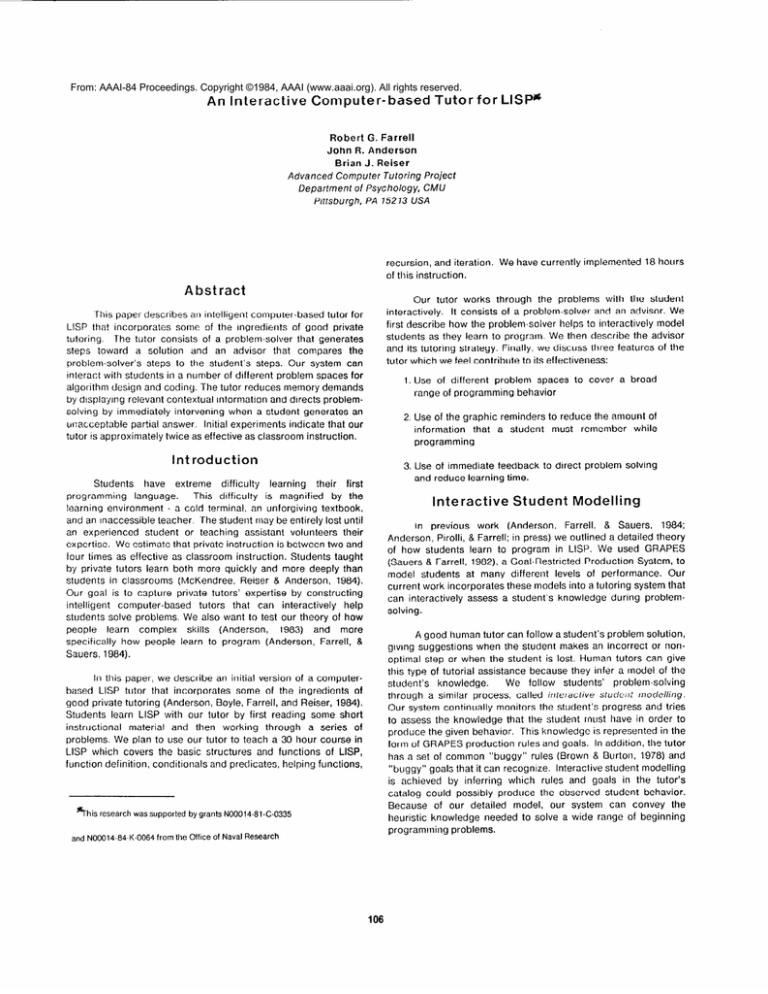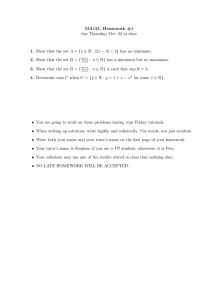
From: AAAI-84 Proceedings. Copyright ©1984, AAAI (www.aaai.org). All rights reserved.
An Interactive
Computer-based
Tutor
for LISP*
Robert G. Farrell
John R. Anderson
Brian J. Reiser
Advanced
Computer
Department
Tutoring
of Psychology,
Pittsburgh,
PA 15273
Project
CMU
USA
recursion, and iteration.
of this instruction.
Abstract
1. Use of different problem spaces
range of programming behavior
3. Use of immediate feedback
and reduce learning time.
Students
have extreme
difficulty
learning
their
first
programming
language.
This difficulty
is magnified
by the
learning environment - a cold terminal, an unforgiving textbook,
and an Inaccessible teacher. The student may be entirely lost until
an experienced
student or teaching assistant volunteers their
expertise. We estimate that private instruction is between two and
four times as effective as classroom instruction. Students taught
by private tutors learn both more quickly and more deeply than
students in classrooms (McKendree,
Reiser & Anderson, 1984).
Our goal is to capture private tutors’ expertise by constructing
intelligent
computer-based
tutors that can interactively
help
students solve problems. We also want to test our theory of how
people
learn complex
skills (Anderson,
1983) and more
specifically how people learn to program (Anderson, Farrell, &
Sauers, 1984).
Interactive
to cover
a broad
to direct problem solving
Student
Modelling
In previous
work (Anderson,
Farrell, & Sauers, 1984;
Anderson, Pirolli, & Farrell; in press) we outlined a detailed theory
of how students learn to program in LISP. We used GRAPES
(Sauers & Farrell, 1982), a Goal-Restricted Production System, to
model students at many different levels of performance.
Our
current work incorporates these models into a tutoring system that
can interactively
assess a student’s knowledge during problemsolving.
A good human tutor can follow a student’s problem solution,
giving suggestions when the student makes an incorrect or nonoptimal step or when the student is lost. Human tutors can give
this type of tutorial assistance because they infer a model of the
We follow students’ problem-solving
student’s
knowledge.
through a similar process, called interactive
studs:
modelling.
Our system continually monitors the student’s progress and tries
to assess the knowledge that the student rnust have in order to
produce the given behavior. This knowledge is represented in the
form of GRAPES production rules and goals. In addition, the tutor
has a set of common “buggy” rules (Brown & Burton, 1978) and
“buggy” goals that it can recognize. Interactive student modelling
is achieved by inferring which rules and goals in the tutor’s
catalog could possibly produce the observed student behavior.
Because of our detailed model, our system can convey the
heuristic knowledge needed to solve a wide range of beginning
programming problems.
In this paper, we describe an initial version of a computerbased LISP tutor that incorporates
some of the ingredients of
good private tutoring (Anderson, Boyle, Farrell, and Reiser, 1984).
Students learn LISP with our tutor by first reading some short
instructional
material and then working through
a series of
problems. We plan to use our tutor to teach a 30 hour course in
LISP which covers the basic structures and functions of LISP,
function definition, conditionals and predicates, helping functions,
and N00014-84-K-0064
18 hours
2. Use of the graphic reminders to reduce the amount of
information
that a student
must remember while
programming
Int reduction
grants
implemented
Our tutor works through
the problems with the student
interactively.
It consists of a problem-solver
and an advisor. We
first describe how the problem-solver
helps to interactively model
students as they learn to program. We then describe the advisor
and its tutoring strategy. Finally. we discuss three features of the
tutor which we feel contribute to its effectiveness:
‘This paper describes an intelligent computer-based
tutor for
LISP tha? incorporates
some of the Ingredients of good private
tutoring.
The tutor consists of a problem-solver
that generates
steps toward a solution and an advisor that compares the
problem-solver’s
steps to the student’s steps. Our system can
interact with students in a number of different problem spaces for
algorithm design and coding. The tutor reduces memory demands
by displaying relevant contextual information and directs problemsolving by immediately intervening when a student generates an
unacceptable partial answer. Initial experiments indicate that our
tutor is approximately twice as effective as classroom instruction.
*his researchwas supported by
We have currently
NOOO14-61-C-0335
from the Office of Naval Research
106
The Tutoring
System
Control
Using Different
Structure
The
LISP tutoring
system
consists
of two
major
components:
the problem-solver
and the advisor. The problem
solver consists of the GRAPES interpreter, novice model rules,
and buggy or “mal” rules (Sleeman, 1982). The advisor is a
production system interpreter much like GRAPES; it also provides
a tutorial strategy and many facilities for creating
tutoring
sessions including graphics, text generation, and parsing.
The
tutor interpreter executes tutoring rules (t-rules) (Clancey, 1982)
which contain patterns for creating explanations
and menu
entries.
Spaces
Producing a program in any language consists of a medley
of algorithm design, coding, and debugging
(Brooks, 1977). A
good human tutor can converse with the student in a variety of
problem spaces.
In this section we describe how our tutor
communicates
in the problem-spaces
involved
in algorithm
design and coding. We are not concerned with debugging since
the tutor never allows the student to produce a final solution that
is incorrect. Our tutor currently utilizes three problem spaces for
coding and algorithm design: a coding space, a means-ends
analysis space, and a problem decomposition space.
The LISP Coding
A problem input to the tutor consists of a small data base of
facts and an initial goal. The problem-solver tries to decompose
the initial goal into easier subgoals, using the novice model rules
and the facts in the data base. The student also tries to
decompose the goal using a goal description generated by the
tutor and the facts that appeared in the instruction booklet given
before each problem session.
Problem
Space
The LISP coding problem space is used in normal problemsolving. The student enters LISP code in a syntax-based editor.
The hierarchical
structure
of the solution is represented
by
symbols to be expanded. The student’s plan for the solution is
represented
by the structure and name of the symbols. For
example:
(defun subset (list1 llst2)
(cond <TERMINATING-CASE>
<RECURSIVE-CASE>
The advisor matches the problem-solver’s next step against
the student’s next step and categorizes the student’s response.
Since there are many ways to solve any interesting programming
problem, the problem-solver
must generate a list of possible
correct and incorrect actions and the advisor matches all of them
against the student’s answer. If the student generates a correct
step toward the solution, the advisor directs the problem-solver to
execute the rule corresponding
to the student’s step. If the
student displays a bug, the system generates text explaining why
the answer was incorrect. If the student fails to produce a correct
answer after a number of trials, the system provides the best
answer and generates an explanation of why the answer was the
best choice.
Interacting
Problem
1
1
illustrates that the student is using CDR recursion to solve the
subset problem. The student can choose to code either the
terminating case or recursive case first.
CDR recursion is a programming plan(Soloway, 1980; Rich
& Shrobe, 1978) well known to expert LISP programmers but
difficult for novices to induce on their own. Part of the utility of a
programming
tutor
is to introduce
powerful
programming
like
CDR
recursion
during
problem-solving
techniques
(Anderson, Boyle, Farrell, and Reiser, 1984).
with the System
The Means-Ends
The tutor’s top window displays explanations,
hints, and
window
provides
a structured
editing
querys, the “code”
environment
for entering LISP code, and the bottom window
displays the problem statement and any planning information or
reminders. The tutor brings the student’s
attention
to new
information by flashing the appropriate window.
Analysis
Problem
Space
The means-ends analysis (Newell & Simon, 1972) space is
used when the student is having trouble producing code for a
problem that can be characterized
by a set of successive
operations on an example.
In this problem space, the student
can develop a solution by sclpplying LISP operators that reduce
differences between the current state and the goal state in the
example.
The tutor interprets each keystroke typed by the student
and gives immediate feedback about correct and incorrect steps.
At any time, the student can press a clarify key to get additional
help about the problem or an info key to access a tree-structured
help facility.
Figure 1 illustrates a sample interaction
with the tutor
during means-ends analysis. The student is trying to produce
some code to get all but the last element of a list. Menus list both
correct and incorrect ways of performing an operation. The menu
entries are generated from patterns associated with both good
and buggy rules in the novice model. Once the student picks a
correct entry, he or she must provide a function that will perform
the operation
described.
The tutor separately
assesses the
student’s knowledge of what operations must be performed and
their ability to irnplement those operations in LISP.
When a student types a function
name, place holders
appear for the function arguments. The structured editor allows
the student to code these arguments in any order. A spelling
corrector and parentheses checker help the student enter code
in a graceful manner,
107
Problem
Decomposition
The problem decomposition
space is used when the
student is having trouble producing code for a problem that can
be easily decomposed into pieces. The conceptual pieces of the
problem may not correspond exactly to the form of the code. The
system displays a menu of possible decompositions
of the
problem and the student must pick the correct answer. The tutor
makes sure that the student actually implements their algorithm
when finally producing the LISP code. Again, the tutor separately
assesses the students’ ability to derive the algorithm from their
ability to implement the algorithm.
Reducing
Memory
Demands
Solving programming
problems requires holding a great
deal of requisite information in a mental working memory. This
requisite information consists of unsolved goals, partial products
of calculations, and descriptions of LISP functions.
We estimate
that half of students’ time spent solving programming problems is
spent recovering
from working
memory failures (Anderson,
Farrell,
& Sauers,
1984). Anderson
and Jeffries
(1984)
demonstrated
that working memory load in one part of a task
causes students to err on other parts of the task, even if those
parts are logically unrelated. Therefore, it is extremely important
that tutors keep working memory load to a minimum.
One way that the tutor keeps working memory load low is
by displaying descriptions of the student’s goals on the terminal
screen. The student’s goals are represented in GRAPES and the
tutoring system uses this representation
to generate english
descriptions.
The tutor displays the overall goal and the current
goal as well as the goals along the shortest path between these
two goals. For example, if the student is solving for the second
argument to lessp in the following code:
(defun
lessoreqp
(x y)
(or (equal x y)
(lessp x A))
then the system would display the following
Our tutor monitors the student with every keystroke, giving
immediate feedback when it detects an error. Since the student
never strays more than one step off of a correct solution path, our
tutor can model the student in great detail. When the student
makes an error, an explanation is generated from a pattern stored
with the buggy rule and a query is generated from the student’s
current goal, directing the student toward a correct answer.
Our tutor cannot generate immediate feedback when the
student’s behavior does not disambiguate which goal he or she is
pursuing. The tutor is silent until it can disambiguate the goal. If
the student is generating an especially ambiguous piece of code,
the tutor may display a menu of goals and ask the student to
decide among them. Once the student’s goal is known, the tutor
can then intervene with tutorial assistance.
Conclusion
Our computer-based
tutor for LISP incorporates
some
abilities of good human tutors. Our system can interact with
students in a number of different problem spaces for algorithm
design and coding. The tutor reduces memory demands by
displaying relevant contextual information and directs problemsolving by immediately intervening when a student generates an
unacceptable partial answer. Our system interactively models the
student by updating a set of production rules. These production
rules also serve as a novice model that follows the student as he
or she solves the problem. We performed an evaluation study on
our tutor (McKendree, Reiser, & Anderson, 1984) which confirms
our belief that it is about twice as effective
as classroom
instruction.
We plan to further test the tutor’s pedagogical
effectiveness by automating a 30 hour LISP course taught in the
fall of 1984.
References
goal context:
Write a function called lessoreqp.
Test if x is less than or equal to y.
Test if x Is less than y.
Write code for the second argument to lessp,
Students
solving
LISP problems
also have trouble
remembering partial results. In our LISP tutor, any calculations
that the student performs on examples are displayed in a window
for later reference.
In addition, the partially-correct
code is
always displayed on the screen.
Immediate
LlSP learning (Anderson, Farrell, & Sauers, 1982), our subjects
spent more than half of their time exploring
wrong paths or
recovering from erroneous steps.
Feedback
Novices spend a large amount of time exploring incorrect
solutions that result in little learning. A good human tutor directs
the student toward correct answers, while still letting the student
learn from mistakes. Lewis and Anderson (1984) have shown that
students learn more slowly when they are given delayed feedback
about their erroneous applications of operators. In our studies of
Anderson, JR. The Architecture
of Cognition.
Harvard University Press 1983.
Cambridge,
MA:
Anderson, J.R., Farrell, R., and Sauers, R. Learning to program in
LISP. Cognitive
Science,
1984, , . in press.
Anderson,
JR., Pirolli, P. and Farrell, R. Learning recursive
programming.
In forthcoming
book edited by Chi, Farr, &
Glaser.
Anderson,
J.R., Boyle, C. F., Farrell, R.G., and Reiser, B.J.
Cognitive Principles in the Design of Computer Tutors.
Paper submitted to the CACM.
Brooks, R.E. Towards a theory of the cognitive
processes in
computer
programming.
lnternafional
Journal
ol ManMachine
St!ldif?S,
1977,
9,
737-751.
Brown, J.S. and Burton, R.R. Diagnostic models for procedural
bugs in basic mathematical skills. Cognitive
Science,
1978,
2,155192.
Clancey, W. J. Tutoring rules for guiding a case method dialogue.
In D. Sleeman and J.S. Brown (Ed.%), intelligent Tutoring
New York: Academic Press, 1982.
Systems,
Lewis,
M. and Anderson,
J.R.
discriminating
problem-solving
The role
operators.
in
of feedback
Submitted.
McKendree, J., Reiser, B.J., and Anderson, J.R. Tutorial goals
and strategies in the instruction
of programming
skills.
Paper submitted to the 1984 conference
of the Cognitive
Science Society.
Newell, A. and Simon, H. Human Problem
Cliffs, N.J.: Prentice-Hall 1972.
Englewood
Solving.
Rich, C. and Shrobe, H. Initial report of a LISP programmers’
apprentice. IEEE Trans. Soft. Eng., 1978, , 456-466.
user’s
manual.
ONR
Sauers,
R., and Farrell, R. GRAPES
Technical Report ONR-82-3, Carnegie-Mellon
University,
1982.
Sleeman, D. Assessing aspects of competence in basic algebra.
In D. Sleeman and J.S. Brown (Eds.), lntelligcnt
Tutoring
Systems, New York: Academic Press, 1982.
Sleeman, D. & Brown, J.S. (Eds.). Intelligent
New York: Academic Press 1982.
Tutoring
Systems.
Soloway, E.M. From problems to programs via plans: The context
and
structure
of knowledge
for
introductory
LISP
programming. COINS Technical Report 80-19, University of
Massachusetts at Amherst, 1980.
Figure
What can we do to change
(a b c d) into
(a b c)?
IF YOU WANTTO:
removed from (a b c d)
get each element and gather
them into a list
have the tutor choose
get information about LISP
PRESS:
1
2
3
4
Menu
1
1
choice:
Very Good.
What
return
function
Function
name:
The function
will have
this case,
apply
Will
remove
just
7 element
from
a list and
an element
from
a list.
the result?
to apply
I don’t know
CDR
will remove
CDR to (a b c d) to remove
d is the last element
CDR, you have
d. Remember
of the argument
to get d in the first position
The LISP Tutor Teaching
list. So, in order
of the list.
with Means-Ends
You
that in
Analysis
to




